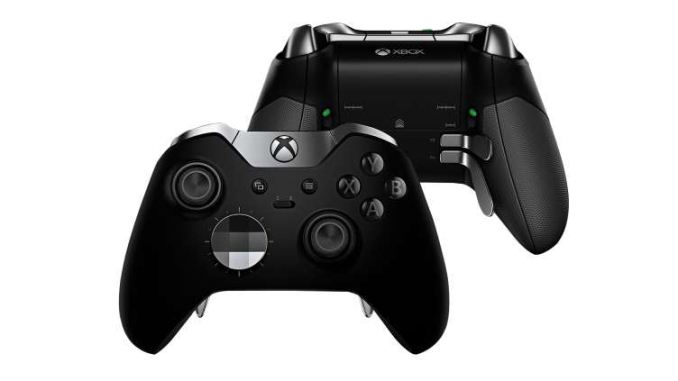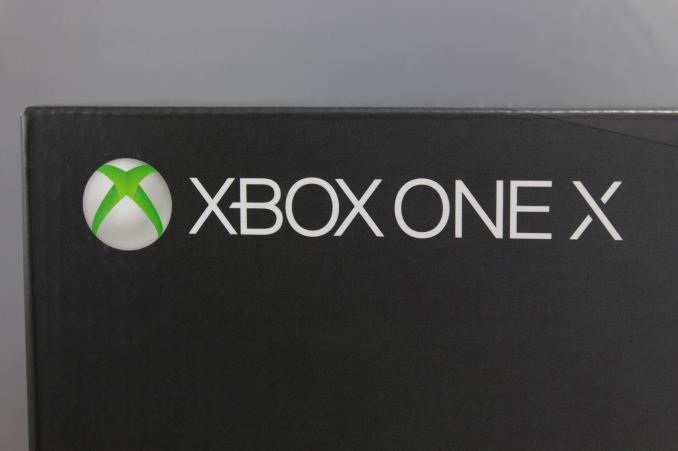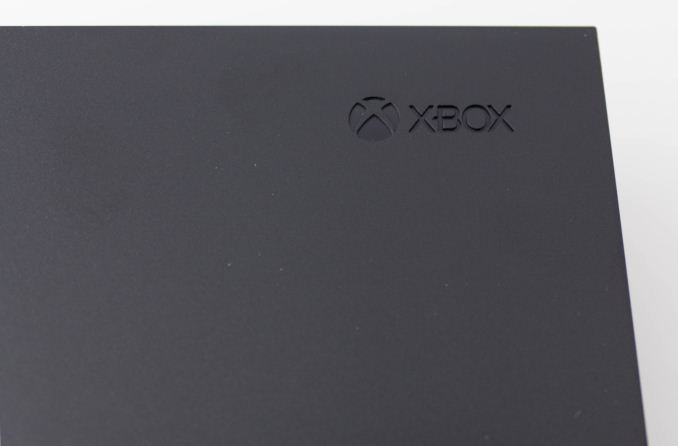The Xbox One X Review: Putting A Spotlight On Gaming
by Brett Howse on November 3, 2017 3:01 AM EST- Posted in
- Consoles
- Microsoft
- Xbox One
- Xbox
- Xbox One X
Final Words
The Xbox One X is the third generation of the Xbox One, with the Xbox One S launching just over a year ago, but this is not just a smaller device. The X is a huge jump in performance over the original console, and if anyone doubted Microsoft’s commitment to the gaming console, this seems to answer it. When the original Xbox One launched against the PlayStation 4, it touted its media capabilities, but came out of the gate with less performance. PlayStation has taken advantage of that misstep, but Xbox is now answering back with a console that leaves no doubt about which one has the most gaming power inside.
Microsoft had some “table stakes” in their ambitions with the Xbox One X, which were no compromise decisions. Their strategy has become “no gamer left behind” and with the Xbox One X, they’ve succeeded. All of the games, apps, and accessories that work with the Xbox One and S will just work, and sometimes better, on the Xbox One X. Compared to the old console strategy of a new device every couple of years, this is a very welcome change. Add in all of the work Microsoft has done with backwards compatibility for the Xbox 360 games, and now even original Xbox games, and it seems like no gamer will be left behind.
With 6 TFLOPS of peak shader throughput, the Xbox One X truly can, and does, game at 4K. But, that doesn’t mean every Xbox One X Enhanced title is going to target 4K. There’s a lot you can do with the extra shader performance to increase visuals, and Microsoft has left it up to the developers to decide how they want to use the extra performance. From the Xbox side, their goal was to provide the same tools, which are already well known to developers, but with more performance available.
Impressively, Microsoft already has over 130 games announced which will offer an Xbox One X Enhanced mode. This is one of the best parts about getting rid of console generations, since there’s already a wide array of content available. Compare this to a new generational launch, when there’s always a slow ramp up of games and content, and it makes buying into the ecosystem a lot easier.
It’s also great to see that the Enhanced titles will offer gamers choice in how they want to utilize the extra performance, for at least a few titles. Choosing between higher framerates, or better visuals, is a great choice to give gamers.
Despite the added performance, the Xbox One X is actually slightly smaller overall than even the Xbox One S, and if you own the original console, it’s hard to believe how much smaller the new one is. This also includes the built-in power supply, which was external on the original console. The overall design of the Xbox One X is quite well done, and will easily blend into any A/V stand. The choice of black as the base color helps here as well, although there will almost certainly be special color versions of the console later on.
The excellent design also continues with a lot of work done on sound and cooling. As we saw in our power draw tests, the Xbox One X can draw up to about 170 Watts of power at full load, but the cooling system is more than up to the task of keeping everything working, without sounding like a leaf blower. The console is barely audible at idle, and we only recorded 41 dB (A) with a SPL meter six inches in front of the console at full load. The vapor chamber cooling system keeps everything in check.
On the gaming front, the Xbox One X does what it was set out to do. On the media side, there’s a lot to like as well, including a built-in UHD Blu-Ray player, support for Dolby Atmos, bitstream passthrough, and HDR 10. It doesn’t quite check all the boxes, since there’s no support for Dolby Vision, but that’s arguably not a huge deal for most people.
Really the only area where the Xbox One X is let down in terms of media playback is Netflix, which forces HDR on for all content when connected to an HDR TV, which plays havoc with the colors of SDR content, which, at the moment, is most of it. It’s a flaw that Amazon Prime avoids, so this is on Netflix, but because of this flaw it’s hard to recommend the Xbox One X as a primary media device. There’s also the fact that it draws 50-60 Watts when streaming video, of course.
Microsoft has also built up an impressive set of accessories for Xbox, including the fantastic Xbox One Elite Controller, and the Xbox Design Labs, where you can custom build your own controller. These are nice touches to the ecosystem. Xbox Live has also improved dramatically since the original One launched, and now includes Games with Gold which provide up to four games every month as part of the subscription. If you want to go all in on gaming subscriptions, there’s also the Xbox Game Pass which gives access to over 100 games for a monthly charge, and Xbox also offers EA Access as well, which provides access to over 50 games for a monthly subscription.
 Xbox One Elite Controller (sold separately)
Xbox One Elite Controller (sold separately)
If you are a console gamer, there’s going to be little to not like about the Xbox One X, except maybe the price. It’s a steep jump, since the Xbox One S can usually be found for close to $250, and that generally includes a game, whereas the Xbox One X is $499 right now with no games included. But even if you don’t own a 4K TV, the Xbox One X is going to provide much better visuals than the S, even though both will output at 1080p, thanks to the downscaling of higher resolution graphics on the X.
Comparing to the PlayStation 4, and PlayStation 4 Pro, Microsoft can compete with both the Xbox One S, which offers a UHD Blu-Ray drive on top of 4K support for media, and HDR support for games, at a low entry level price, but the Xbox One X is priced about $100 higher than the PlayStation 4 Pro. This is the same price gap that existed when the Xbox One and Playstation 4 first launched. The difference is this time, the extra $100 gains you a lot of performance. Xbox isn't the market leader right now though, so this might be a gamble.
The Xbox One X sets a new bar for console performance. The team seems like they’ve gotten back to gaming as a focus, which is great to see. Gaming is always about more than just the hardware though, and any console needs a great set of exclusives to drive adoption. Microsoft has some of their own IP, such as Forza, Gears of War, and Halo, but they are still going to face some tough competition. They have the hardware now though, to drive console gaming to the next level.













128 Comments
View All Comments
Hixbot - Monday, November 6, 2017 - link
The gaming scenarios that are currently locked at 30fps are CPU bound, they cannot reach 60fps because of the CPU.Samus - Friday, November 3, 2017 - link
CPU and core count are unimportant for DirectX 12 games. Microsoft would have likely been happy to go with 4 cores to give them even more GPU real estate in Xbox One X, but they had to keep it backwards compatible and that would have been severely ruined by doing so.I don't understand why the original PS4/Xbox One were 8-core CPU's...it's been pretty obvious for at least a decade that GPU's are more critical to graphics, and since both consoles were effectively built during the DX12-era which was pushing even further away from CPU limitations...it seems Microsoft in particular went 8-core just to appear "on paper" competitive with the PS4. Yet another mistake to add to the list of f-up's on the Xbox One.
I passed this whole generation. The PS3/Xbox 360 were really the last revolutionary consoles. I spent this generation focusing on PC gaming, and I don't regret it.
Hixbot - Monday, November 6, 2017 - link
There is most certainly a CPU bottleneck if 60fps is the target.Rufnek - Monday, November 6, 2017 - link
@SamusYou are spitting non-sense. Your comments would ring true for pretty much everything up to 2015. Thankfully Sony & M$ were looking further out than your experiences. CPU need to have a lot of cores running at high speeds. At best, they need to tackle all the other parts that the GPU doesn't. At worst, the CPU needs to overlap and assist the GPU. AC: Origins is one of the prime examples.
As for CPU cores...there is a reason Intel is now trying to catch up to AMD on the # of cores. Expect a lot of software companies to following gaming devs in cpu core utilizations. More cores = better.
tipoo - Friday, November 3, 2017 - link
Imagine if people got GPU mining going on consoles, we'd never get those either lolSamus - Friday, November 3, 2017 - link
Shhhhhh. ;)dguy6789 - Sunday, November 5, 2017 - link
Well, considering that a regular Xbox One or PS4 runs games significantly better than a $500 PC, I would imagine the X would compare extremely favorably.xenol - Monday, November 6, 2017 - link
Every time I see a comparison being made, a few things get left behind that make me think the comparison is not fair. For instance, I see people omitting the BD drive, which I find makes the comparison pointless. Gaming consoles aren't just for gaming, at least on the Sony and Microsoft camp. They're trying to be a complete entertainment system. So you can't just pick and choose which features you want and keep the same budget for comparison's sake.Silma - Tuesday, November 7, 2017 - link
During the conference call for the last quarter, Microsoft warned investors that the Xbox One X would weigh on its financial results next quarter.So basically Microsoft doesn't make a dime on it. I doubt you'll find a better deal on a PC.
jai_86 - Monday, December 24, 2018 - link
If you want to play Halo, Gears of War, Forza or Crackdown, pretty well.